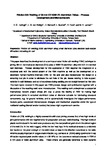Semiautomatic friction stir welding of 38 mm OD 6082-T6 aluminium tubes
| dc.contributor.author | Hattingh, DG | |
| dc.contributor.author | von Welligh, LG | |
| dc.contributor.author | Bernard, D | |
| dc.contributor.author | Susmel, L | |
| dc.contributor.author | Tovo, R | |
| dc.contributor.author | James, Neil | |
| dc.date.accessioned | 2016-09-16T16:11:27Z | |
| dc.date.available | 2016-09-16T16:11:27Z | |
| dc.date.issued | 2016-12 | |
| dc.identifier.issn | 0924-0136 | |
| dc.identifier.uri | http://hdl.handle.net/10026.1/5455 | |
| dc.description.abstract |
This paper describes the development of a semi-automated friction stir welding (FSW) technique for joining 38 mm nominal outer diameter (OD) tubes of 6082-T6 aluminium alloy with 3.5 mm nominal wall thickness. The technique incorporates a retracting tool in order to avoid leaving a substantial hole in the joint line after extracting the tool at the end of the welding process. This is one of very first applications of FSW to small diameter tubular geometries to be reported in the open literature and the technique is capable of producing small-scale production runs (circa 100) of welded tube specimens with consistent tensile and fatigue properties. The tensile strength of the extruded 6082-T6 tube was 303 MPa while the joint efficiency of the weld was 0.55 both for complete tube specimens and for microtensile specimens. This compares well with values reported in the literature for 3 mm flat plate specimens of 6082 alloy. | |
| dc.format.extent | 255-266 | |
| dc.language | en | |
| dc.language.iso | en | |
| dc.publisher | Elsevier BV | |
| dc.subject | 6082 aluminium alloy | |
| dc.subject | Electron backscatter diffraction | |
| dc.subject | Friction stir welding | |
| dc.subject | Retracting pin tool | |
| dc.subject | Small diameter tube | |
| dc.title | Semiautomatic friction stir welding of 38 mm OD 6082-T6 aluminium tubes | |
| dc.type | journal-article | |
| dc.type | Journal Article | |
| plymouth.author-url | http://gateway.webofknowledge.com/gateway/Gateway.cgi?GWVersion=2&SrcApp=PARTNER_APP&SrcAuth=LinksAMR&KeyUT=WOS:000383291500028&DestLinkType=FullRecord&DestApp=ALL_WOS&UsrCustomerID=11bb513d99f797142bcfeffcc58ea008 | |
| plymouth.volume | 238 | |
| plymouth.publication-status | Accepted | |
| plymouth.journal | JOURNAL OF MATERIALS PROCESSING TECHNOLOGY | |
| dc.identifier.doi | 10.1016/j.jmatprotec.2016.07.027 | |
| plymouth.organisational-group | /Plymouth | |
| plymouth.organisational-group | /Plymouth/Faculty of Science and Engineering | |
| plymouth.organisational-group | /Plymouth/Faculty of Science and Engineering/School of Engineering, Computing and Mathematics | |
| plymouth.organisational-group | /Plymouth/Users by role | |
| plymouth.organisational-group | /Plymouth/Users by role/Academics | |
| dcterms.dateAccepted | 2016-07-16 | |
| dc.rights.embargodate | 2018-7-18 | |
| dc.rights.embargoperiod | 24 months | |
| rioxxterms.versionofrecord | 10.1016/j.jmatprotec.2016.07.027 | |
| rioxxterms.licenseref.uri | http://www.rioxx.net/licenses/under-embargo-all-rights-reserved | |
| rioxxterms.licenseref.startdate | 2016-12 | |
| rioxxterms.type | Journal Article/Review |


